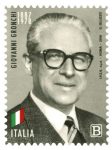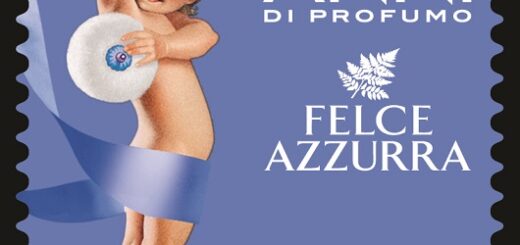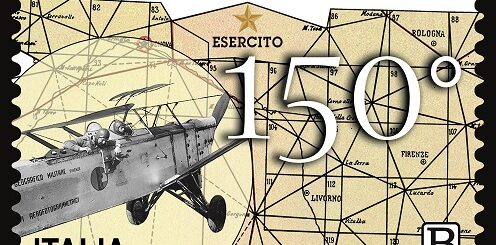POSTE ITALIANE 16^ Emissione del 22 giugno 2018 – Giovanni GRONCHI
Giovanni Gronchi, è nato a Pontedera il 10 settembre 1887 è morto a Roma il 17 ottobre 1978 è stato un politico italiano, terzo Presidente della Repubblica Italiana, tra il 1955 e il 1962.
Già Ministro dell’Agricoltura, Industria e Commercio nei governi Bonomi II, Bonomi III e De Gasperi I, fu il primo democristiano ad essere eletto Presidente della Repubblica.
Suo padre, Sperandio, era contabile di un panificio e, per arrotondare, faceva il piazzista di salumi. Militò nelle organizzazioni giovanili cattoliche, assumendo incarichi direttivi ed esprimendo simpatia per le tesi moderniste di Romolo Murri. Frequentò il liceo scientifico arcivescovile Santa Caterina di Pisa e si laureò in lettere all’Università degli Studi di Pisa quale allievo della Scuola normale superiore. Tra il 1911 e il 1915 insegnò filosofia nei licei di Parma, Massa-Carrara, Bergamo e Monza: partecipò alla Prima guerra mondiale come ufficiale di fanteria, guadagnandosi una medaglia d’argento e una di bronzo al valor militare.
Il 18 gennaio 1919, Gronchi partecipò alla riunione di fondazione del Partito Popolare Italiano, convocata da don Luigi Sturzo all’albergo Santa Chiara di Roma: nello stesso anno venne eletto deputato. Nel 1920 venne chiamato a dirigere la Confederazione italiana dei lavoratori di orientamento cattolico; l’anno dopo, è eletto per la seconda volta alla Camera dei deputati.
Sottosegretario all’Industria nel governo Mussolini, si dimise dall’incarico allorché il PPI uscì dalla maggioranza governativa (1923). Nel 1924 Gronchi, insieme a Giuseppe Spataro e Giulio Rodinò, fece parte del triumvirato che resse il Partito Popolare a seguito delle dimissioni di Luigi Sturzo e fu rieletto deputato.
Nel 1925, gli fu attribuito un insospettabile elogio, da parte di Piero Gobetti, sulla rivista La Rivoluzione liberale: «Per uno spirito spregiudicato è una fortuna incontrare a un congresso popolare un uomo come Gronchi. Nessun altro cattolico ha la sua finezza e agilità parigina, né la sua devozione al pensiero moderno, né il suo culto per lo spirito di contraddizione, provvidenza e sale della società».
Gronchi partecipò alla secessione dell’Aventino e, nel 1926, con l’adozione delle leggi fascistissime (R.D. n. 1848/26), fu dichiarato decaduto dal mandato parlamentare. Successivamente si appartò dalla vita politica e prima lavorò come rappresentante di commercio e poi intraprese iniziative industriali. Rimasto vedovo della prima moglie, nel 1941 si sposò con Carla Bissatini, di venticinque anni più giovane.
Gronchi fondatore della DC e leader della corrente di sinistra
Il 29 settembre del 1942, Gronchi, insieme ad alcuni esponenti politici cattolici, quali Alcide De Gasperi, Achille Grandi, Piero Malvestiti,Giuseppe Brusasca ed altri, prese parte alla prima riunione clandestina propedeutica alla fondazione della Democrazia Cristiana, nell’abitazione di Giorgio Enrico Falck, noto imprenditore milanese. Il 19 marzo 1943, il gruppo si riunì a Roma, in casa di Giuseppe Spataro, per discutere e approvare il documento, redatto da De Gasperi, Le idee ricostruttive della Democrazia Cristiana, considerato l’atto di fondazione ufficiale del nuovo partito.
L’elezione alla Presidenza della Repubblica
All’elezione del Presidente della Repubblica del 1955, il segretario nazionale della DC, Amintore Fanfani candidò il Presidente del Senato Cesare Merzagora, che non raccoglieva l’unanimità dei consensi del partito democristiano a causa delle divisioni interne in chiave antifanfaniana e antiscelbiana ed eletto come indipendente, sia pure nelle liste DC.
Al secondo scrutinio, la sinistra DC si espresse per Gronchi, che raggiunse 127 voti. Essendo allora chiaro il fallimento della candidatura Merzagora, anche i voti dell’opposizione di sinistra confluirono su Giovanni Gronchi (terzo scrutinio). Dopo un vano tentativo di convincerlo al ritiro, Fanfani fu costretto a candidare ufficialmente il Presidente della Camera alla massima carica dello Stato. Il 29 aprile 1955, al quarto scrutinio, Gronchi venne eletto Presidente della repubblica con 658 voti su 883, compresi i suffragi della destra monarchica.
Come presidente della Camera, toccò a lui presiedere la seduta comune e leggere a voce alta le schede con il suo nome che via via gli venivano porte e continuò a leggerle fino alla fine. Si interruppe solo pochi istanti, quando un applauso del Parlamento segnò il raggiungimento del quorum. Gronchi si alzò allora dallo scranno e, con in mano una scheda, ringraziò l’assemblea con un breve inchino. Poi sedette di nuovo e continuò a leggere le schede con una certa tensione della voce. Quando ebbe letto l’ultima scheda pregò al microfono il Vicepresidente della Camera, Giovanni Leone, di procedere allo scrutinio e di proclamare il risultato. Fra gli applausi si alzò e guadagnò l’uscita.
Leone ufficializzò poco dopo l’elezione del nuovo Capo dello Stato e ne venne poi eletto successore come presidente della Camera. Secondo il regolamento, quando Gronchi si alzò e si ritirò nel suo ufficio, anche il Presidente del Senato Merzagora – che gli era vicino – lasciò il posto al vice presidente del Senato, che sedette accanto al vicepresidente Leone.
Fine del mandato presidenziale
Le tensioni fra Gronchi e gli esponenti principali del suo partito, gli pregiudicarono la rielezione ad un secondo mandato, cui avrebbe ambito con l’appoggio del Presidente dell’Eni Enrico Mattei. Secondo il giornalista Renzo Trionfera, Mattei avrebbe messo a disposizione un miliardo di lire per corrompere alcuni parlamentari al fine di rieleggerlo. Il segretario politico della Democrazia Cristiana, Aldo Moro, che non vedeva di buon occhio tali manovre, propose invece al partito la candidatura di Antonio Segni, che fu eletto Presidente della Repubblica al nono scrutinio (1962). Nei primi otto scrutini, Gronchi riuscì comunque a ottenere tra i 20 e i 45 voti, pur non essendo il candidato ufficiale del suo partito.
L’11 maggio 1962 cessò il settennato (il suo giuramento, infatti, era avvenuto l’11 maggio 1955) e Gronchi divenne senatore di diritto e a vita. Morì il 17 ottobre del 1978, ma la notizia passò in secondo piano in quanto i giornali e i mass media furono completamente dedicati all’elezione di Karol Wojtyła quale nuovo Pontefice, avvenuta il giorno prima.
Gronchi è sepolto presso il Cimitero della Misericordia, a Pontedera.
Giovanni Gronchi, was born in Pontedera September 10, 1887 died in Rome on October 17, 1978 was an Italian politician, the third President of the Italian Republic, between 1955 and 1962.
Former Minister of Agriculture, Industry and Commerce in the Bonomi II, Bonomi III and De Gasperi I governments, he was the first Christian Democrat to be elected President of the Republic.
His father, Sperandio, was an accountant of a bakery and, to round up, he was a salami dealer. He was a militant in Catholic youth organizations, taking on managerial positions and expressing sympathy for the modernist theses of Romolo Murri. He attended the archiepiscopal scientific high school Santa Caterina di Pisa and graduated in literature at the University of Pisa as a student of the Scuola normale superiore. Between 1911 and 1915 he taught philosophy in high schools in Parma, Massa-Carrara, Bergamo and Monza: he participated in the First World War as an infantry officer, earning a silver medal and a bronze medal for military valor.
On January 18, 1919, Gronchi participated in the founding meeting of the Italian Popular Party, convened by Don Luigi Sturzo at the Santa Chiara hotel in Rome: in the same year he was elected deputy. In 1920 he was called to direct the Italian Confederation of Catholic orientation workers; the following year, he was elected for the second time in the Chamber of Deputies.
Undersecretary of Industry in the Mussolini government, he resigned from office when the PPI left the government majority (1923). In 1924 Gronchi, together with Giuseppe Spataro and Giulio Rodinò, was part of the triumvirate that ruled the Popular Party following the resignation of Luigi Sturzo and was re-elected deputy.
In 1925, an unexpected eulogy was attributed to him by Piero Gobetti, in the magazine Liberal Revolution: “It is fortunate to meet a man like Gronchi at a popular congress for a spirit of recklessness. No other Catholic has his subtlety and Parisian agility, nor his devotion to modern thought, nor his cult for the spirit of contradiction, providence and salt of society “.
Gronchi took part in the secession of the Aventine and, in 1926, with the adoption of the fascist laws (R.D. No. 1848/26), was declared ruled by the parliamentary mandate. Subsequently he withdrew from political life and first worked as a representative of commerce and then undertook industrial initiatives. Widowed widower of his first wife, in 1941 he married Carla Bissatini, twenty-five years younger.
Gronchi, founder of the DC and leader of the left wing
On September 29, 1942, Gronchi, together with some Catholic politicians, such as Alcide De Gasperi, Achille Grandi, Piero Malvestiti, Giuseppe Brusasca and others, took part in the first clandestine meeting preparatory to the foundation of Christian Democracy, in the home of Giorgio Enrico Falck, a well-known Milanese entrepreneur. On March 19, 1943, the group met in Rome, at the home of Giuseppe Spataro, to discuss and approve the document, drafted by De Gasperi, The Reconstructive Ideas of Christian Democracy, considered the official foundation of the new party.
The election to the Presidency of the Republic
At the election of the President of the Republic of 1955, the national secretary of the DC, Amintore Fanfani candidated the President of the Senate Cesare Merzagora, who did not collect the consensus of the Christian Democrat party because of internal divisions in an antifanfaniana and antiscelbiana key and elected as independent, albeit in the DC lists.
On the second ballot, the DC left was expressed by Gronchi, who reached 127 votes. Since the candidacy of Merzagora was then clear, the votes of the left opposition also merged with Giovanni Gronchi (third ballot). After a vain attempt to convince him to retire, Fanfani was forced to officially nominate the President of the Chamber to the highest office of the state. On April 29, 1955, in the fourth ballot, Gronchi was elected President of the Republic with 658 votes out of 883, including the suffrages of the monarchist right.
As president of the Chamber, it was up to him to chair the joint session and read aloud the cards with his name that gradually came to him and continued to read them until the end. He paused only a few moments, when an applause of Parliament signaled the achievement of the quorum. Gronchi then stood up from the bench and, holding a card, thanked the assembly with a short bow. Then he sat down again and continued reading the tabs with a certain tension in his voice. When he had read the last card he asked the Vice-President of the Chamber, Giovanni Leone, to proceed with the microphone and to proclaim the result. Among the applause he got up and earned the exit.
Leone made official shortly after the election of the new Head of State and was later elected successor as president of the Chamber. According to the regulations, when Gronchi got up and retired to his office, the President of the Senate Merzagora – who was close to him – also gave way to the vice president of the Senate, who sat next to Vice President Leone.
End of the presidential term
The tensions between Gronchi and the main exponents of his party, jeopardized his re-election to a second term, to which he would have coveted with the support of the President of ENI Enrico Mattei. According to journalist Renzo Trionfera, Mattei would have made available a billion lire to bribe some parliamentarians in order to re-direct it. The Christian Democratic political secretary, Aldo Moro, who did not look favorably at these maneuvers, instead proposed to the party the candidacy of Antonio Segni, who was elected President of the Republic in the ninth scrutiny (1962). In the first eight scrutinies, Gronchi succeeded in getting between 20 and 45 votes, even though he was not the official candidate of his party.
On 11 May 1962 the seven-year term ceased (his oath, in fact, had occurred on 11 May 1955) and Gronchi became a senator by right and for life. He died on October 17, 1978, but the news passed into the background because the newspapers and the mass media were completely dedicated to the election of Karol Wojtyła as the new Pope, the day before.
Gronchi is buried at the Cimitero della Misericordia, in Pontedera.
| data /date | 22.06.2018 |
| n. catalogo / n. catalog | Michel 4048 – YT 3809 -Un 3891 |
| dentellatura/Serration | 11 |
| stampa/printing | fustellatura – rotocalco |
| tipo di carta/paper type | bianca patinata neutra |
| stampato | I.P.Z.S. Roma |
| fogli/sheet | 45 |
| dimensioni/dimensions | 40 x 30 mm |
| disegnatore /designer | G. Ieluzzo |
| tiratura | 400.000 |







